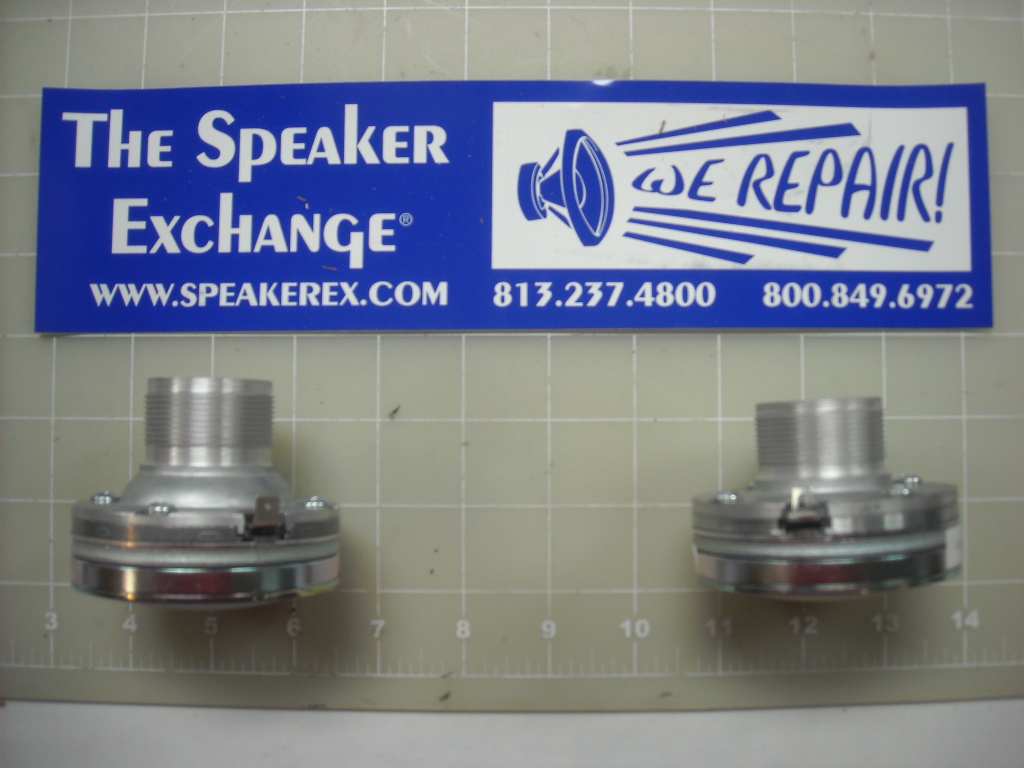This afternoon I had an idea for a JBL M2 for those that don't want to drop $10,000.
But first, some background on the M2.
First off, JBL M2 is a two way monitor which uses a similar format as my reference monitors. (Gedlee Summa.) There's a 15" waveguide atop a 15" woofer.
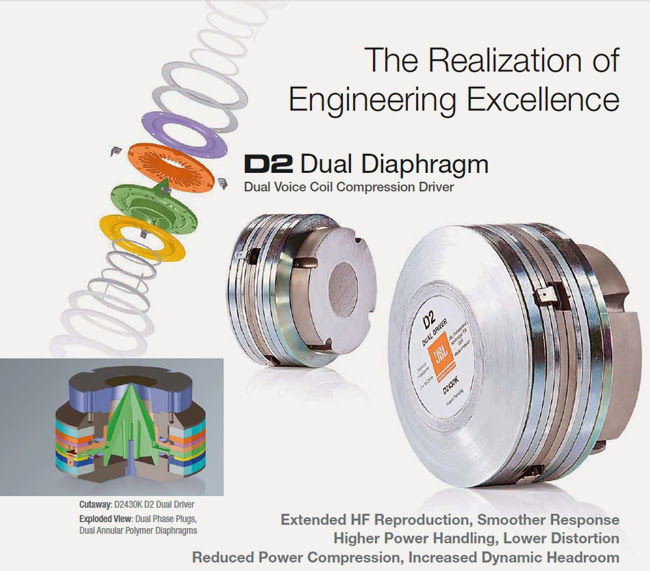
The compression driver in the M2 is very interesting. It's a dual ring radiator, very similar to the BMS compression drivers, except with two diaphragms instead of one. BMS sells some coaxial compression drivers, but the D2430K is different. In the D2430K the diaphragms face each other. (Not 100% sure if it's push-pull or push-push.)


Here's a pic of a BMS compression driver that Paul Spencer posted to his blog. Basically it's a ring radiator, that mylar ring is the diaphragm.
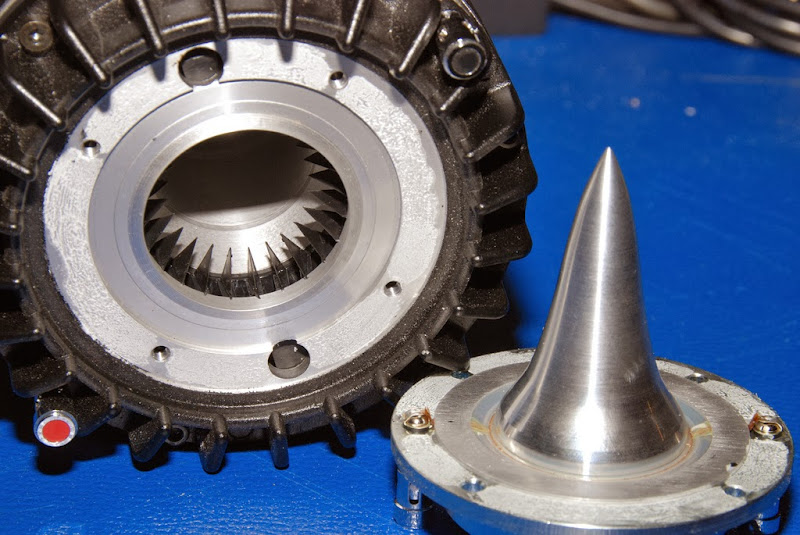

In this cutaway of another BMS, you can see how the sound radiates, basically the output from the ring radiates toward the throat. One of the reasons that the BMS has such good bandwidth is because every point on the ring is equidistant to the throat. (IE, draw a straight line from the throat to the ring, and that distance will be the same no matter where you draw it.)
So the idea I had was to replace the ring radiator with an array of very small drivers.
The 1/2" tweeters used in the Keele CBT array are a great candidate.
More details in the next post...
But first, some background on the M2.
An externally hosted image should be here but it was not working when we last tested it.
First off, JBL M2 is a two way monitor which uses a similar format as my reference monitors. (Gedlee Summa.) There's a 15" waveguide atop a 15" woofer.

The compression driver in the M2 is very interesting. It's a dual ring radiator, very similar to the BMS compression drivers, except with two diaphragms instead of one. BMS sells some coaxial compression drivers, but the D2430K is different. In the D2430K the diaphragms face each other. (Not 100% sure if it's push-pull or push-push.)


Here's a pic of a BMS compression driver that Paul Spencer posted to his blog. Basically it's a ring radiator, that mylar ring is the diaphragm.


In this cutaway of another BMS, you can see how the sound radiates, basically the output from the ring radiates toward the throat. One of the reasons that the BMS has such good bandwidth is because every point on the ring is equidistant to the throat. (IE, draw a straight line from the throat to the ring, and that distance will be the same no matter where you draw it.)
So the idea I had was to replace the ring radiator with an array of very small drivers.
An externally hosted image should be here but it was not working when we last tested it.
The 1/2" tweeters used in the Keele CBT array are a great candidate.
More details in the next post...
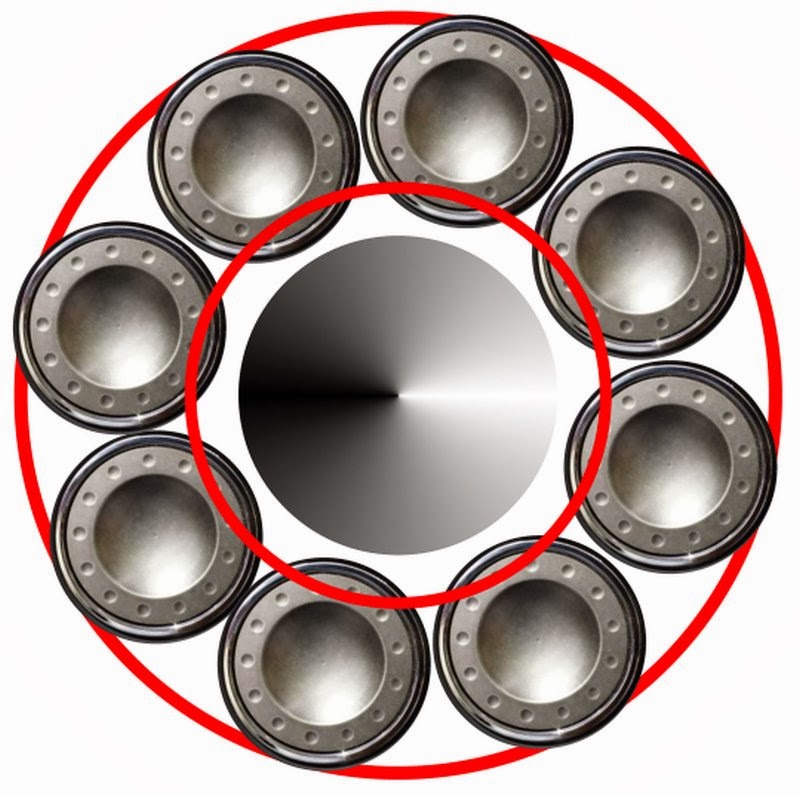
Here's a pic of what the ring shaped array would look like.
There are eight of the Parts Express tweeters in the array.
In this configuration, the ring is under five centimeters in diameter. (To be exact, it's 4.57cm in diameter.)
The sound radiates the exact same way as the BMS and the JBL, the only difference is that we're using $20 worth of computer speakers instead of $4000 worth of compression drivers.
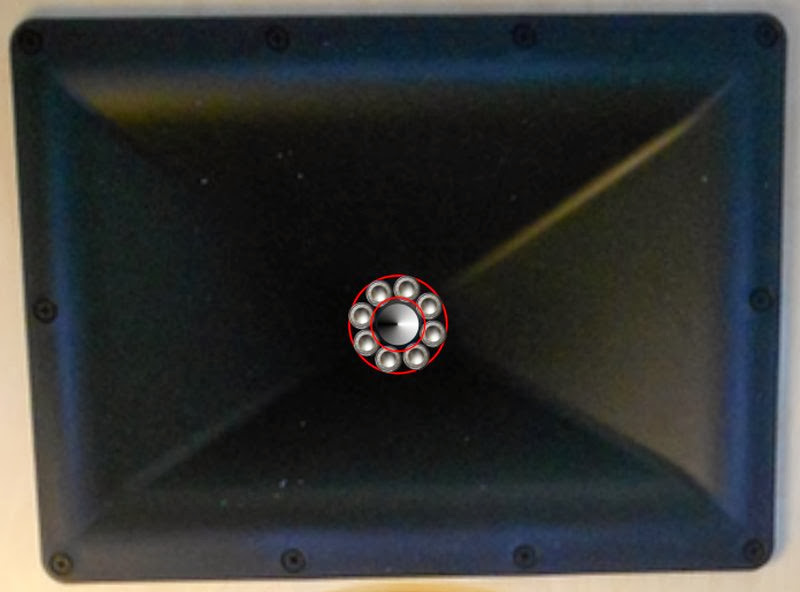
Here's a pic of what it would look like with a waveguide in front of it, in this case the QSC PL-000446GP. ($35 at PE.)

The array of 1/2" tweeters radiates into the horn exactly like this ^^^
QSC PL-000446GP Replacement Waveguide Horn for HPR152i | 245-625
1/2" Dome Tweeter Element 10 Pcs. | 275-010
Eight of the tweeters and one of the waveguides cost a whopping $60.
By comparison's sake, the D2430K doesn't have a listed price that I can find, though they can be found on eBay for about $450 used
The BMS 4550 is $150

Here's a comparison of a B&C DE25 on a 15" waveguide, versus the same waveguide driver by eight of the Dayton 1/2" tweeters.
The output of the B&C is way higher, of course, because the B&C has a sensitivity of nearly 110dB while the Dayton has a sensitivity of 65(!) dB
In the sim the Dayton array is getting 20 watts, while the B&C is getting one.
Yes, a conventional compression driver will get louder, but for the home, I don't need to hit 120dB. Plus, this is different and cheap!
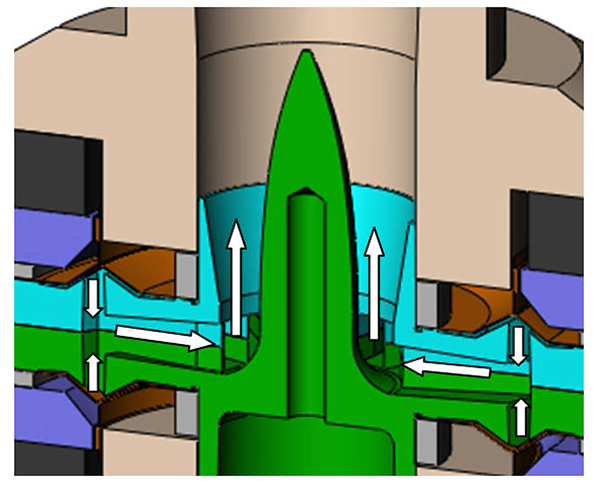
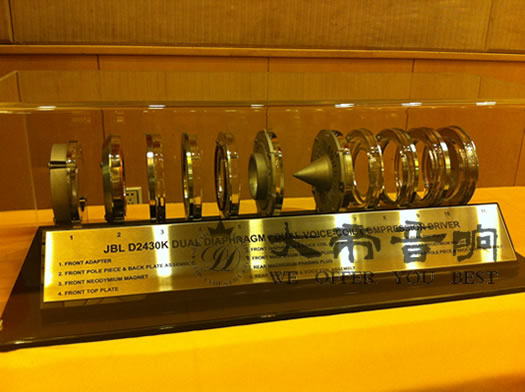
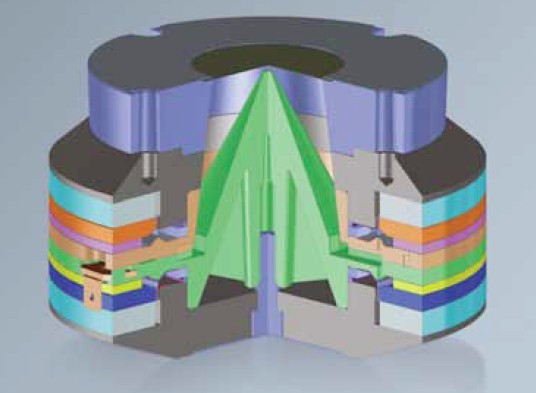
If the output level is too low, there's a bunch of ways to make it higher:
1) You can double the number of drivers in the array by making it push-push or push-pull. Basically the tweeters will be face to face in a ring, exactly like the JBL 2430K
2) You can make the ring bigger. The ring in the BMS 4550 is 4.4cm. The ring in my second post, using the Dayton tweeters, is about the same size. The ring in the D2430K is much larger, 7.6cm in diameter. The downside to using a big ring is that you need a bigger throat; the JBL M2 uses a 3.8cm throat. A bigger throat will allow for more output, but it's also tricky to find waveguides with a 1.5" throat. (Note that there's a cone shaped phase plug in the center of the throat.)
3) You can do both. If you do push-push rings and you increase the diameter to the same size as the JBL M2, you can squeeze twenty six tweeters on each side. Cost goes up too, up to $63 per side, but it's still a small fraction of a BMS or a JBL.
So it would make noise when fed signal, beyond that what is comparable to the M2?
I'm starting to think your crazy.
Barry.
Oh I'm definitely nuts, it's the whole reason I chose my pseudonym
I obsess about audio projects the same way that some people obsess about their favorite sports team
Patrick,In the sim the Dayton array is getting 20 watts, while the B&C is getting one.
Yes, a conventional compression driver will get louder, but for the home, I don't need to hit 120dB. Plus, this is different and cheap!
So at near full power (20 watts compared to a maximum of 32) the 8 driver array can hit considerably less than a conversational sound level in the high frequency range (no chance of equalizing 20 dB back, that would require 2000 watts, poof), and the wide throat will result in ratty high frequency response.
This idea has as much in common with the JBL M2 as a wooden dog sled has with a Mercedes.
How much is crack cocaine going for where you live
Art
I'm a huge fan of smaller compression drivers; I've used BMS 4540ND and Celestion CDX1-1425 almost exclusively in all of my diy projects for about half a decade now.
My reference monitors use B&C, and in the top octave, the smaller compression drivers sound 'airier.'
I know a lot of people prefer the BMS 4550 to the 4540ND; the former goes lower. This is because the 4550 has a 1.75" voice coil and a larger diaphragm than the 4540ND which uses 1.5".
Here's a quick look at the lineage of some of these drivers, based on some data from audioheritage and avsforum.
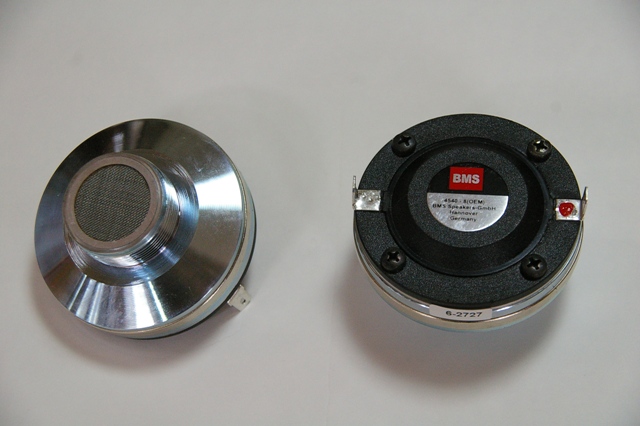 1) First came the BMS. This is a 4540ND, with a 1.5" voice coil. Output extends past 20khz and it's recommended to use a 1.9khz xover.
1) First came the BMS. This is a 4540ND, with a 1.5" voice coil. Output extends past 20khz and it's recommended to use a 1.9khz xover.
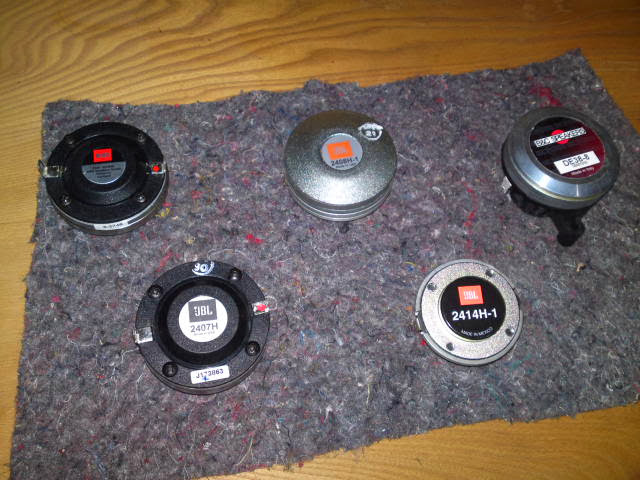 2) Then came the JBL 2407H, which looks suspiciously similar to the BMS 4540ND. Is it the same driver? See Ring Radiator Comparisons - Page 7
2) Then came the JBL 2407H, which looks suspiciously similar to the BMS 4540ND. Is it the same driver? See Ring Radiator Comparisons - Page 7
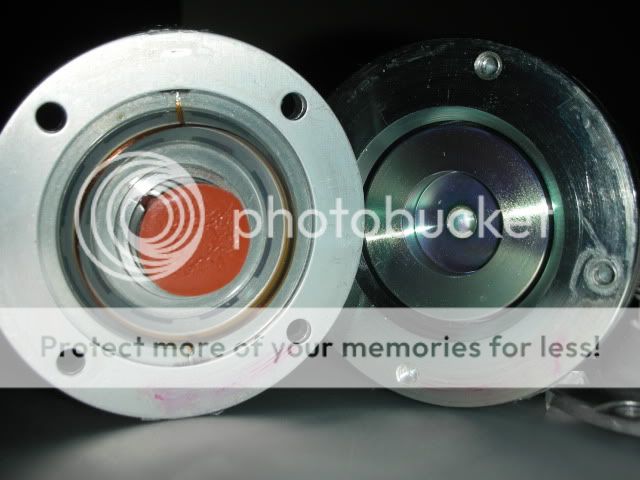
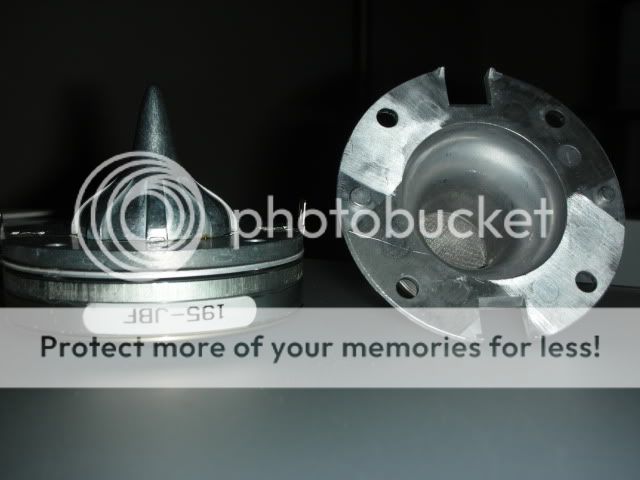
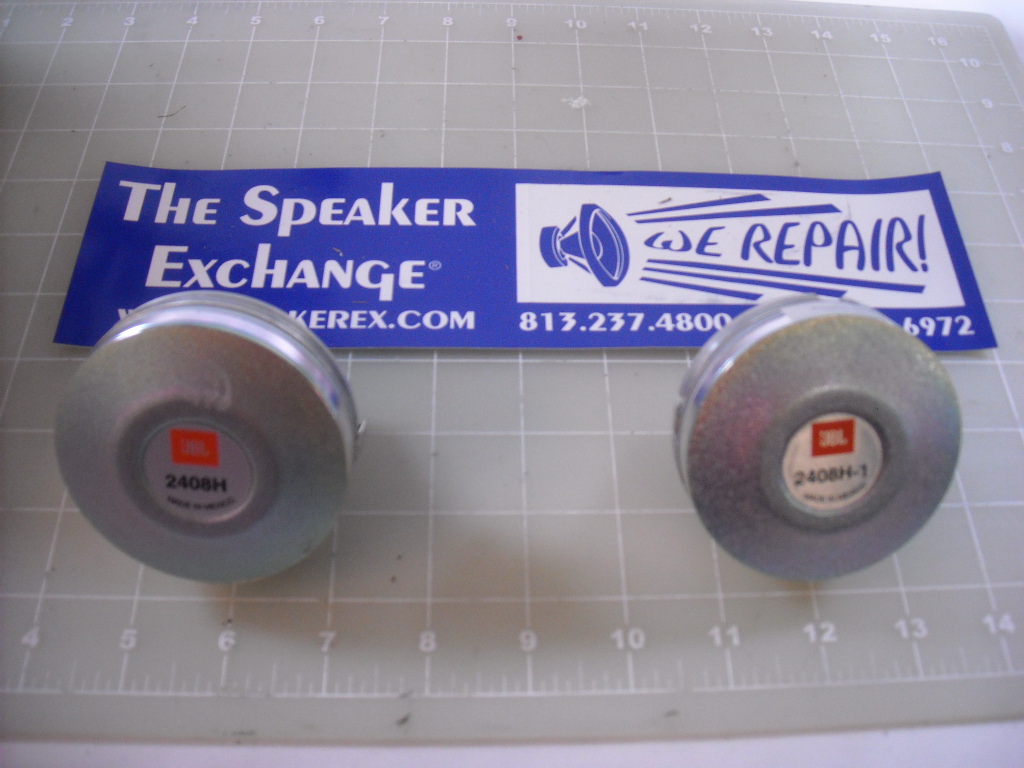 3) Next came the JBL 2408H. This one seems to be an evolution of the 2407H, but with a much different phase plug. Note how the area of the phase plug is much smaller than in the 2407H and the 4540ND.
3) Next came the JBL 2408H. This one seems to be an evolution of the 2407H, but with a much different phase plug. Note how the area of the phase plug is much smaller than in the 2407H and the 4540ND.
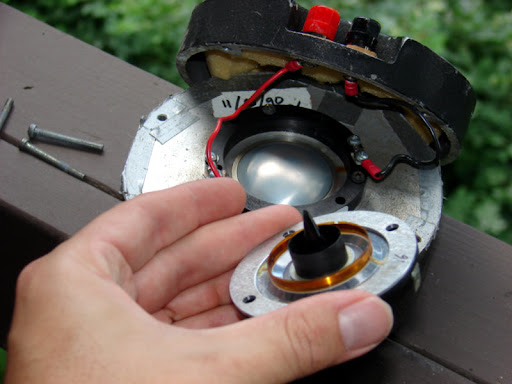 Here's my 4540ND taken apart; see how the phase plug length is about the same, but the size is smaller?
Here's my 4540ND taken apart; see how the phase plug length is about the same, but the size is smaller?
4) After the 2408H came the 2408H-1. The phase plug in the 2408H-1 is *completely* different from the phase plug in the 2408H. (2408H is similar to the 2407H and 4540ND, but still a bit different.)
As far as I know, this is the first appearance of the new square phase plug documented in http://d27vj430nutdmd.cloudfront.net/19395/99548/99548-32.pdf. According to the literature, "The phasing plug’s slots have a unique pattern arranged diagonally with respect to the ring-diaphragm to provide averaging of the acoustic energy at varying positions to reduce chamber resonances."
Providing further evidence that the D2430K is an evolution of the JBL 2408H-1 which is an evolution of the JBL 2408H which is an evolution of the BMS 4540ND, the patent for the phase plug used in the 2408H is from the same designer that did the D2430K, Alexander Voishvillo, senior manager of transducer engineering at JBL.
Here's the patent on the 2408H, from six years ago:
Patent US20070147647 - Phasing plug for a compression driver - Google Patents
And the D2430K, from a year ago:
https://www.google.com/patents/US8280091
My reference monitors use B&C, and in the top octave, the smaller compression drivers sound 'airier.'
I know a lot of people prefer the BMS 4550 to the 4540ND; the former goes lower. This is because the 4550 has a 1.75" voice coil and a larger diaphragm than the 4540ND which uses 1.5".
Here's a quick look at the lineage of some of these drivers, based on some data from audioheritage and avsforum.






4) After the 2408H came the 2408H-1. The phase plug in the 2408H-1 is *completely* different from the phase plug in the 2408H. (2408H is similar to the 2407H and 4540ND, but still a bit different.)
As far as I know, this is the first appearance of the new square phase plug documented in http://d27vj430nutdmd.cloudfront.net/19395/99548/99548-32.pdf. According to the literature, "The phasing plug’s slots have a unique pattern arranged diagonally with respect to the ring-diaphragm to provide averaging of the acoustic energy at varying positions to reduce chamber resonances."
Providing further evidence that the D2430K is an evolution of the JBL 2408H-1 which is an evolution of the JBL 2408H which is an evolution of the BMS 4540ND, the patent for the phase plug used in the 2408H is from the same designer that did the D2430K, Alexander Voishvillo, senior manager of transducer engineering at JBL.
Here's the patent on the 2408H, from six years ago:
Patent US20070147647 - Phasing plug for a compression driver - Google Patents
And the D2430K, from a year ago:
https://www.google.com/patents/US8280091
Patrick,
So at near full power (20 watts compared to a maximum of 32) the 8 driver array can hit considerably less than a conversational sound level in the high frequency range (no chance of equalizing 20 dB back, that would require 2000 watts, poof), and the wide throat will result in ratty high frequency response.
This idea has as much in common with the JBL M2 as a wooden dog sled has with a Mercedes.
How much is crack cocaine going for where you live?
Art
Smoking crack would probably be a cheaper habit than audio for me.
Just placed an order for the following:
1) 20 of the 1/2" tweeters from Dayton ($50)
2) One JBL 2408H-1 ($109)
On the upside, the JBL is surprisingly affordable, a bit cheaper than a B&C DE250:
JBL 2408H-1 Compression Driver 365011-001X | Speaker ExchangeSpeaker Exchange
John,Smoking crack would probably be a cheaper habit than audio for me.
Just placed an order for the following:
1) 20 of the 1/2" tweeters from Dayton ($50)
2) One JBL 2408H-1 ($109)
I have known some engineers who have put the equivalent cost of a house up their nose, it does not appear you have gone that far with your audio habit
You have many times expressed liking the extra "air" that tiny HF drivers have in the top octave, and have shown a simulation showing that the 1/2" tweeters from Dayton are incapable of that attribute when used as horn drivers.
You have also recently mentioned there are no redeeming features of a 2" driver, which is what the exit size of your proposed 1/2" tweeter ring would be.
Why do you enjoy buying things guaranteed to produce dismal results?
Art
Maybe a strange question, but:
How many of these projects did you actually finish?
I like your crazy ideas but get the impression the projects all run to a dead end at some point.
Hope you finish that Monster Massive project...
This is something I feel really strongly about, and it's one of the reason that I'm always promoting Geddes speakers on the forum.
Andy Wehmeyer, formerly of JBL, said it better than I could when he wrote the following:
"In my 25 years of working in this industry, I've listened to thousands of cars and I can count the ones that sounded great on two hands. Most of them have serious problems and some of the worst ones are IASCA winners. In fact, I'm in China doing a 4-day audio training for a bunch of dealers. Many of them have brought their cars, so we're having a tuning session each afternoon. 50% of these guys have plans to change all the equipment in their cars because they don't sound good. In every case so far, none of the equipment has been the cause of poor performance. In every case, it's the installation, the adjustments or the system design. All of these cars have cool fiberglass boxes, amps, components with tweeters mounted in reasonable locations, but they all sound like *** except for one. THe one that sounded great was the simplest system of the bunch but the guy had actually set the crossover points correctly. "
I had that in my sig for a few years, because it perfectly reflects the reason that I've invested thousands of hours on this hobby, but I have exactly ONE of my projects still running. Basically guys like Geddes and Danley and the folks at JBL know better than I do, so for critical listening, I'll simply buy or clone their products. It's a lot of fun to experiment with audio, but the devil is in the details and that's why I have the following in my listening 'rooms':
my car : a seven channel Lexicon system (part of Harman, of course.)
my living room: Vandersteen
bedroom: Gedlee Summas
garage: JBL Control Now
Spending the big bucks for the Summas was kinda painful but I don't regret it one bit, and I think that more hobbyists should have a reference monitor that's designed by a pro.
John,
I have known some engineers who have put the equivalent cost of a house up their nose, it does not appear you have gone that far with your audio habit.
I have this 'pet theory' that the violence in Mexico is partly due to a LACK of profits. IE, the media creates this meme that drug dealers are making money hand over fist, but economists like Steven Levitt have shown that the profits are pretty meager. IMHO the violence isn't due to skyrocketing profits, it's due to existing groups going to war over a shrinking market. In the past few years there have been cases where they've gone into iron ore mining(1) and kidnapping(2). I live close enough to Mexico that I can walk there, and legal alternatives to illegal drugs are available from hundreds of pharmacies. (Amphetamines are a component of the legal drug adderal, there are synthetic opiates in dozes of legal painkillers, etc.)
You have many times expressed liking the extra "air" that tiny HF drivers have in the top octave, and have shown a simulation showing that the 1/2" tweeters from Dayton are incapable of that attribute when used as horn drivers.
You have also recently mentioned there are no redeeming features of a 2" driver, which is what the exit size of your proposed 1/2" tweeter ring would be.
Why do you enjoy buying things guaranteed to produce dismal results?
Art
To learn things, of course.
If I hadn't spent hours poring through the patents of Alex Voshivillo(sp?) I wouldn't have discovered that the JBL 2408H-1 appears to have some real and significant improvement on a design that I already like... And it's cheap.
I know the DE250 is affordable and ubiquitous, but once in a while you find a really great driver that barely anyone has discovered.
Another cool thing about the 2408H-1 is that the waveguide is affordable, widely available, and looks to be fairly decent.
A 2408H, plus a JBL waveguide, plus a 12" or a 15" woofer might offer some of the sound that I like so much in my Summa, but with more 'air' at the top end.
Danley described something similar when he wrote the following about the BMS ring radiators:
ot all compression drivers are created equal or create the same problems.
For example, in subjective listening, on two identical 50 degree conical horns, both made “flat”, both having similar responses and acoustic phase, still sounded very different.
Of two of the best modern compression drivers available, The B&C DE250 sounded very much like a horn compared next to the BMS 4550 which sounded very “open” and airy.
The possibly interesting part was the BMS driver has a different internal approach, which so far as the horn is concerned, starts as an acoustically small conical horn inside the driver. There are no phase plug summation slots, (which by path length, generally would appear to produce a converging, not diverging wave front one would want in a source that was large enough to already exhibiting some directivity at the throat).
As a result, with an acoustically small origin and small acoustic size where the break point in angles was, there was much less “origin” garbage from the BMS style phase plug arrangement which produces a diverging wave front from inside the driver.(3)
1) : Mexican Drug Cartels Now Make Money Exporting Ore : NPR
2) : Soldiers rescue 165 people brutally kidnapped in Mexico ? adults and children held terrified for weeks at gunpoint - NY Daily News
3) : http://www.diyaudio.com/forums/multi-way/100392-beyond-ariel-146.html
It's a lot of fun to experiment with audio, but
the devil is in the details ...
Not in the details, in logical thinking
Lots of info out there is placed just to cause confusion.
Isn't the whole point of the fancy compression driver high SPL at low frequencies? If we're throwing out SPL, I think a poor's M2 would be more like QSC waveguide + some cheap compression driver + serious miniDSP implementation. I mean, really it should involve a waveguide that holds up down to 800Hz or so, but I don't think there is one available for cheap.
From Tom's quote it sounds like the rather rough break point in the 50 degree conical horns he compared result in less “origin” garbage from the BMS style phase plug.A 2408H, plus a JBL waveguide, plus a 12" or a 15" woofer might offer some of the sound that I like so much in my Summa, but with more 'air' at the top end.
Danley described something similar when he wrote the following about the BMS ring radiators:
For example, in subjective listening, on two identical 50 degree conical horns, both made “flat”, both having similar responses and acoustic phase, still sounded very different.
Of two of the best modern compression drivers available, The B&C DE250 sounded very much like a horn compared next to the BMS 4550 which sounded very “open” and airy.
The possibly interesting part was the BMS driver has a different internal approach, which so far as the horn is concerned, starts as an acoustically small conical horn inside the driver. There are no phase plug summation slots, (which by path length, generally would appear to produce a converging, not diverging wave front one would want in a source that was large enough to already exhibiting some directivity at the throat).
As a result, with an acoustically small origin and small acoustic size where the break point in angles was, there was much less “origin” garbage from the BMS style phase plug arrangement which produces a diverging wave front from inside the driver.(3)
3) : http://www.diyaudio.com/forums/multi-way/100392-beyond-ariel-146.html
The Summa horn is basically conical, the difference is between it and a conical being in the critical throat area, this detail probably makes it relatively immune to the difference in driver design. I doubt you will find the JBL 2408H on a JBL waveguide will have more "air".
My tests using conical horns with a very smooth driver to horn interface don't seem to exhibit any less "airiness" using the BMS style phase plug/annular ring diaphragm compared to annular slot phase plug dome diaphragm drivers.
Take a listen to them and tell me if you hear more "air" in one type over the other:
http://www.diyaudio.com/forums/multi-way/212240-high-frequency-compression-driver-evaluation.html
The HF drivers alone without LF mixed in can be heard here:
http://soundforums.net/varsity/4329-high-frequency-compression-driver-evaluation.html
Art
Last edited:
Take a listen to them and tell me if you hear more "air" in one type over the other:
http://www.diyaudio.com/forums/multi-way/212240-high-frequency-compression-driver-evaluation.html
The HF drivers alone without LF mixed in can be heard here:
High Frequency Compression Driver Evaluation
Art
Thanks for that!
I had some BMS 2" and 1" drivers and they sounded spitty, gritty compared to other drivers like the older EV's in your test. I really like the 1012s. I bought the BMS because I read on the internets people love them! LOL - The B&C 250 sounds like that too that's why I wonder why people actually use them for hifi when there are so much better sounding drivers available? Do they really like them or are they just naive to what's available and better?
Pooh,Thanks for that!
I had some BMS 2" and 1" drivers and they sounded spitty, gritty compared to other drivers like the older EV's in your test. I really like the 1012s. I bought the BMS because I read on the internets people love them! LOL - The B&C 250 sounds like that too that's why I wonder why people actually use them for hifi when there are so much better sounding drivers available? Do they really like them or are they just naive to what's available and better?
"Better" is a subjective term.
Most people have not had the opportunity to actually compare different HF drivers under controlled conditions, so their opinions often have little objectivity.
The B&C driver I tested was the flattest of the six, the BMS drivers had the most extended HF.
The EVDH1A was capable of the most output with the least distortion, but all the drivers were capable of clean output at levels most would find more than adequate for home use, with the exception that the 1" exit BMS would require a higher crossover point for clean reproduction than the other drivers were capable of.
The recordings of the drivers allow anyone to decide for themselves what the different drivers sound like, rather than relying on subjective reports, or trying to compare driver "A" on horn "B" specifications to driver "C" on horn "D".
Art

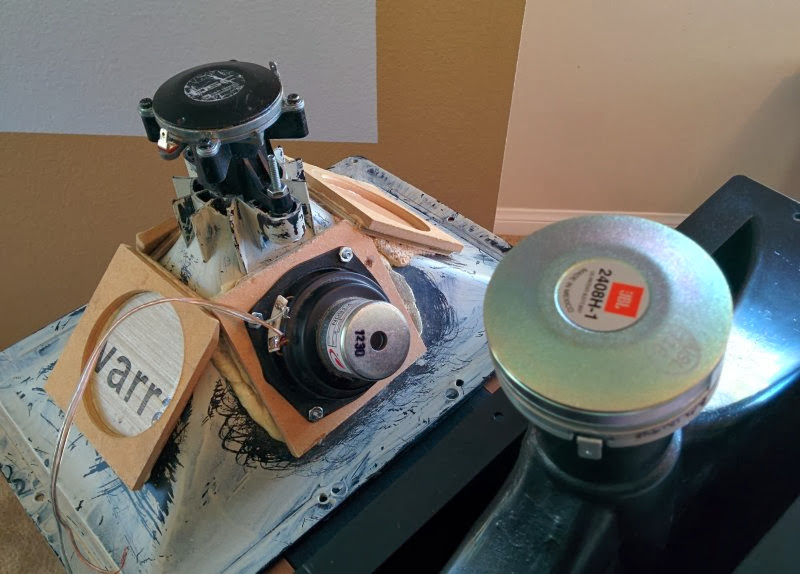
The JBLs showed up quite fast. Surprised how beefy it is; it's significantly larger and heavier than my ol' standby, the Celestion CDX1-1425.
I bought a pile (pyle?) of screw on horns to test. Those Pyles are so cheap they're practically free.
It's occurred to me that this will probably end up looking a lot like an Econowave. If you took the M2, replaced the dual-diaphragm driver with a JBL 2408H-1, and replaced the trick JBL waveguide with a Pyle knockoff, that's not too far from an Econowave.
On the upside, I believe that the JBL for $109 is probably better sounding that the Selenium that's typically used with the Econowave. (I haven't heard the Selenium, but I've heard the B&C DE250, and if the DE250 is better than the Selenium than the JBL is in good company, because the BMS 4540ND sounds better to me than the DE250 as long as you don't run it too low.)
- Home
- Loudspeakers
- Multi-Way
- JBL M2 for The Poors
